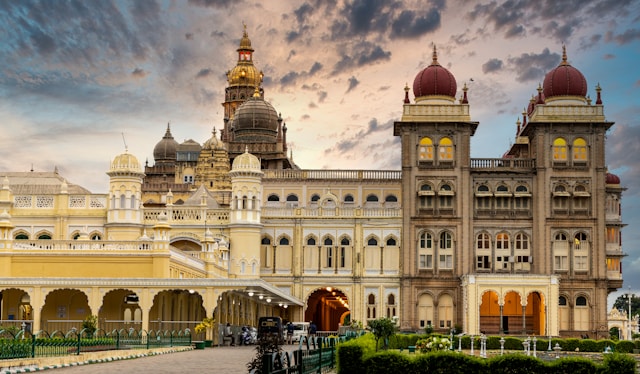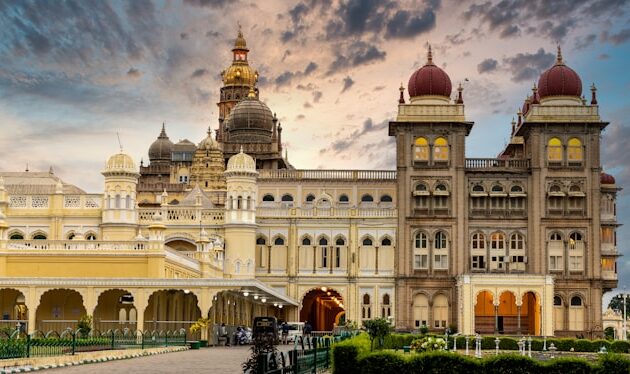
The Mysore Palace, also known as the Amba Vilas Palace, is not merely an architectural marvel; it is a testament to the regal splendor of Karnataka’s Wadiyar dynasty. Standing magnificently in the heart of Mysuru, this palace represents a blend of historical, cultural, and architectural legacy, drawing millions of tourists from around the globe. As one of India’s most visited monuments, Mysore Palace serves as a vivid window into the glorious past of South India’s royal heritage.
Historical Significance: Tracing the Wadiyar Legacy

The roots of Mysore Palace are deeply embedded in the legacy of the Wadiyars, who ruled the Kingdom of Mysore for over six centuries. The original palace was built in the 14th century, but after a series of demolitions and reconstructions, the current structure was completed in 1912 under the reign of Maharaja Krishnaraja Wadiyar IV, designed by the British architect Henry Irwin.
The palace has witnessed the transformation of Mysore from a princely state to a modern city while preserving its traditional ethos. Each generation of Wadiyars contributed to the palace’s evolution, enhancing its beauty with imported artifacts, intricate carvings, and international architectural styles.
Architectural Marvel: Indo-Saracenic Elegance
The Mysore Palace architecture is a brilliant synthesis of Indo-Saracenic, Dravidian, Rajput, and Gothic styles, creating a visual spectacle unlike any other. Built with fine grey granite and deep pink marble domes, the palace features intricately carved columns, majestic arches, and enormous wooden doors inlaid with ivory.
The three-story structure is adorned with turrets, domes, and expansive courtyards. One of its most iconic features is the five-story tower with a golden dome that gleams under the sun, representing the royal glory of Karnataka.
Opulent Interiors: A Tour Through Time
Stepping inside the Mysore Palace reveals an opulent interior soaked in history. The Ambavilasa (Diwan-e-Khas) is the private audience hall where the king met his advisors. The hall features stained glass ceilings, chandeliers imported from Czechoslovakia, and intricately carved rosewood doors.
The Kalyana Mantapa (Marriage Pavilion) is another highlight, with its octagonal-shaped dome, peacock-themed stained glass, and mosaic tile flooring imported from England. The palace houses a rich collection of artifacts, weapons, musical instruments, royal attire, and portraits of the royal family, offering a detailed glimpse into the regal lifestyle of the Wadiyars.
Cultural Grandeur: Dussehra at Mysore Palace
The Mysore Dasara Festival is a ten-day celebration of Karnataka’s cultural vibrancy, with the palace at its epicenter. Held every October, this festival commemorates the victory of good over evil, symbolized by Goddess Chamundeshwari slaying the demon Mahishasura.
During Dasara, the palace is illuminated with over 100,000 light bulbs, creating a mesmerizing display visible across Mysuru. The festivities include processions of decorated elephants, cultural performances, folk dances, music, and fireworks, drawing lakhs of tourists each year.
Artifacts and Museums: Preserving the Past
Mysore Palace is home to several priceless antiques and museum collections. From traditional Mysore paintings and intricate woodwork to armory and ceremonial regalia, the exhibits preserve centuries of royal history.
The Royal Armoury showcases weapons ranging from swords, daggers, and spears to long-range firearms, all adorned with silver, gold, and precious stones. The Painting Gallery displays unique styles such as Mysore painting and Raja Ravi Varma’s masterpieces, encapsulating the artistry of Southern India.
Gardens and Grounds: Serenity Around Royalty
Surrounding the Mysore Palace are lush gardens, meticulously maintained to complement the grandeur of the structure. Palm trees, ornamental plants, and fountains blend seamlessly into the landscape, offering visitors a serene atmosphere.
The Jayamarthanda Gate, the main entrance, opens into a wide courtyard used for public events and cultural exhibitions. The palace’s illumination show and sound-and-light spectacle held in the evenings narrate the tale of Mysore’s royal lineage, captivating audiences of all ages.
Location and Accessibility: Gateway to South India’s Splendor
Located in the center of Mysuru city, Mysore Palace is easily accessible via road, rail, and air. The Mysuru Junction railway station and Mandakalli Airport ensure seamless connectivity for domestic and international tourists. Well-connected roadways from Bangalore, just 145 km away, make it a popular weekend destination.
Visitors can explore the palace with guided tours available in multiple languages, ensuring that the cultural and historical essence is comprehensively communicated to all.
Conservation and Restoration: Honoring a Glorious Past
Mysore Palace is maintained by the Government of Karnataka under the Department of Archaeology and Museums. Regular conservation efforts ensure the longevity of the palace’s structure and artwork. Restoration projects focus on preserving original artifacts, cleaning frescoes, and strengthening the architectural integrity while maintaining authenticity.
Sustainability is also a key focus, with initiatives promoting eco-friendly tourism, heritage awareness programs, and digital archives for educational and historical research.
Beyond the Palace: Exploring Mysore’s Royal City
Mysuru, once the capital of the Kingdom of Mysore, is dotted with heritage sites that complement the grandeur of the palace. Sites such as Chamundi Hill, St. Philomena’s Church, Lalitha Mahal Palace, and Jaganmohan Palace add to the rich historical and cultural tapestry of the city.
The city is also known for its sandalwood products, Mysore silk sarees, and traditional sweets like Mysore Pak, making it a hub for cultural tourism and handicraft exploration.
Conclusion: A Monument That Echoes Timeless Majesty
Mysore Palace is not just a tourist attraction; it is a living emblem of Karnataka’s royal narrative, echoing tales of valor, culture, and timeless elegance. With its impeccable architecture, grand celebrations, rich interiors, and historical significance, the palace stands tall as a jewel in India’s heritage crown.
It is a destination where history comes alive, inviting travelers to step back in time and immerse themselves in the regal splendor of Southern India’s most celebrated dynasty.